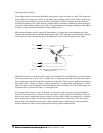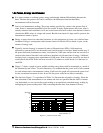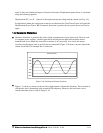
Q
Figure 1.8 shows another example of energy and demand. In this case, each bar represents the
energy consumed in a 15-minute interval. The energy use in each interval typically falls between 50
and 70 kWh. However, during two intervals the energy rises sharply and peaks at 100 kWh in
interval number 7. This peak of usage will result in setting a high demand reading. For each interval
shown the demand value would be four times the indicated energy reading. So interval 1 would have
an associated demand of 240 kWh/hr. Interval 7 will have a demand value of 400 kWh/hr. In the
data shown, this is the peak demand value and would be the number that would set the demand
charge on the utility bill.
Q
As can be seen from this example, it is important to recognize the relationships between power,
energy and demand in order to control loads effectively or to monitor use correctly.
1.3:
Reactive
Energy
and
Power
Factor
Q
The real power and energy measurements discussed in the previous section relate to the quantities
that are most used in electrical systems. But it is often not sufficient to only measure real power and
energy. Reactive power is a critical component of the total power picture because almost all real-life
applications have an impact on reactive power. Reactive power and power factor concepts relate to
both load and generation applications. However, this discussion will be limited to analysis of
reactive power and power factor as they relate to loads. To simplify the discussion, generation will
not be considered.
Q
Real power (and energy) is the component of power that is the combination of the voltage and the
value of corresponding current that is directly in phase with the voltage. However, in actual practice
the total current is almost never in phase with the voltage. Since the current is not in phase with the
voltage, it is necessary to consider both the inphase component and the component that is at
quadrature (angularly rotated 90
o
or perpendicular) to the voltage. Figure 1.9 shows a single-phase
voltage and current and breaks the current into its in-phase and quadrature components.
Electro Industries/GaugeTech
Doc # E107706 V1.25 1-8
Intervals Æ
Kilowatt-hours
20
40
60
80
100
Figure 1.8: Energy Use and Demand


















